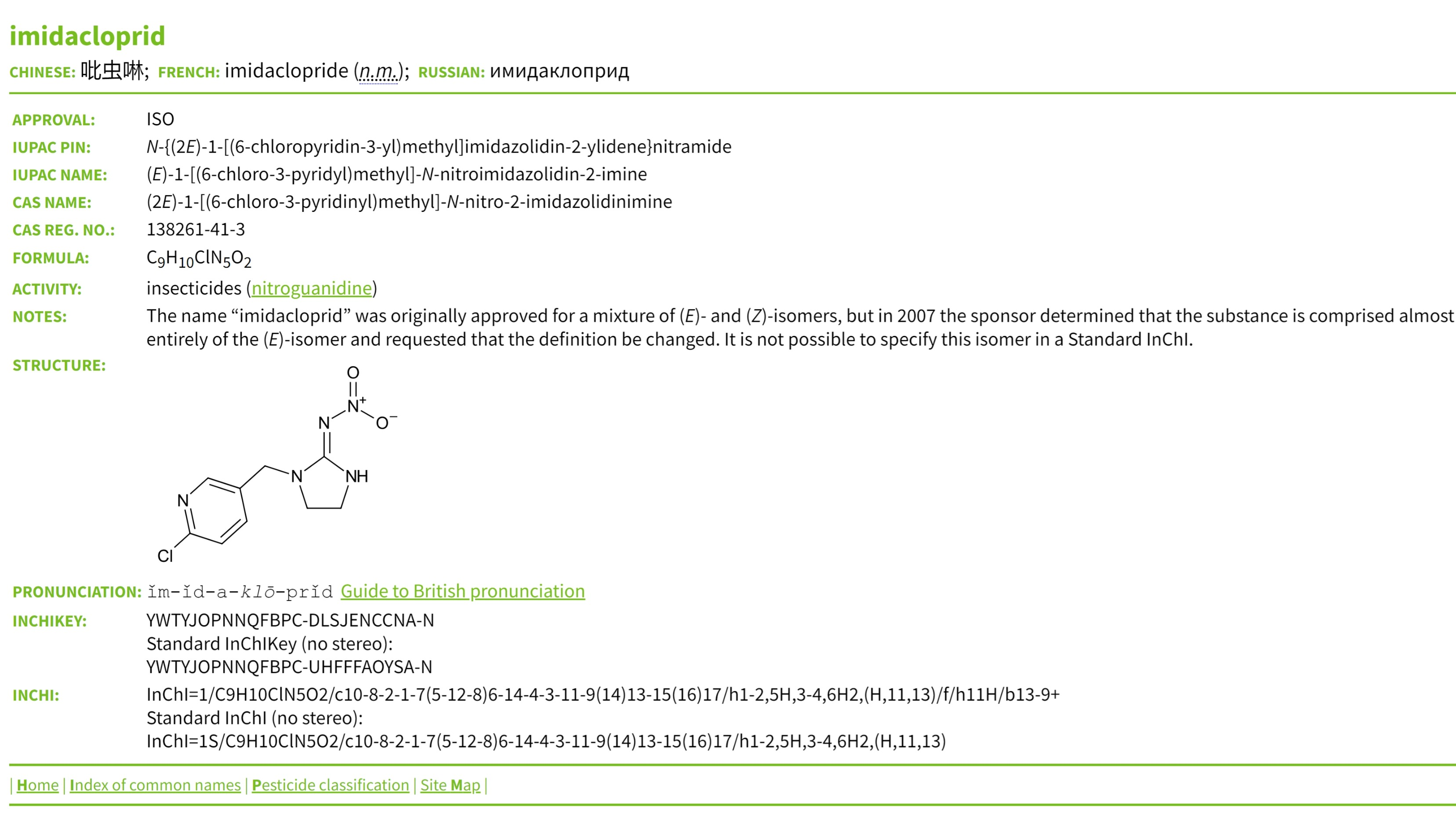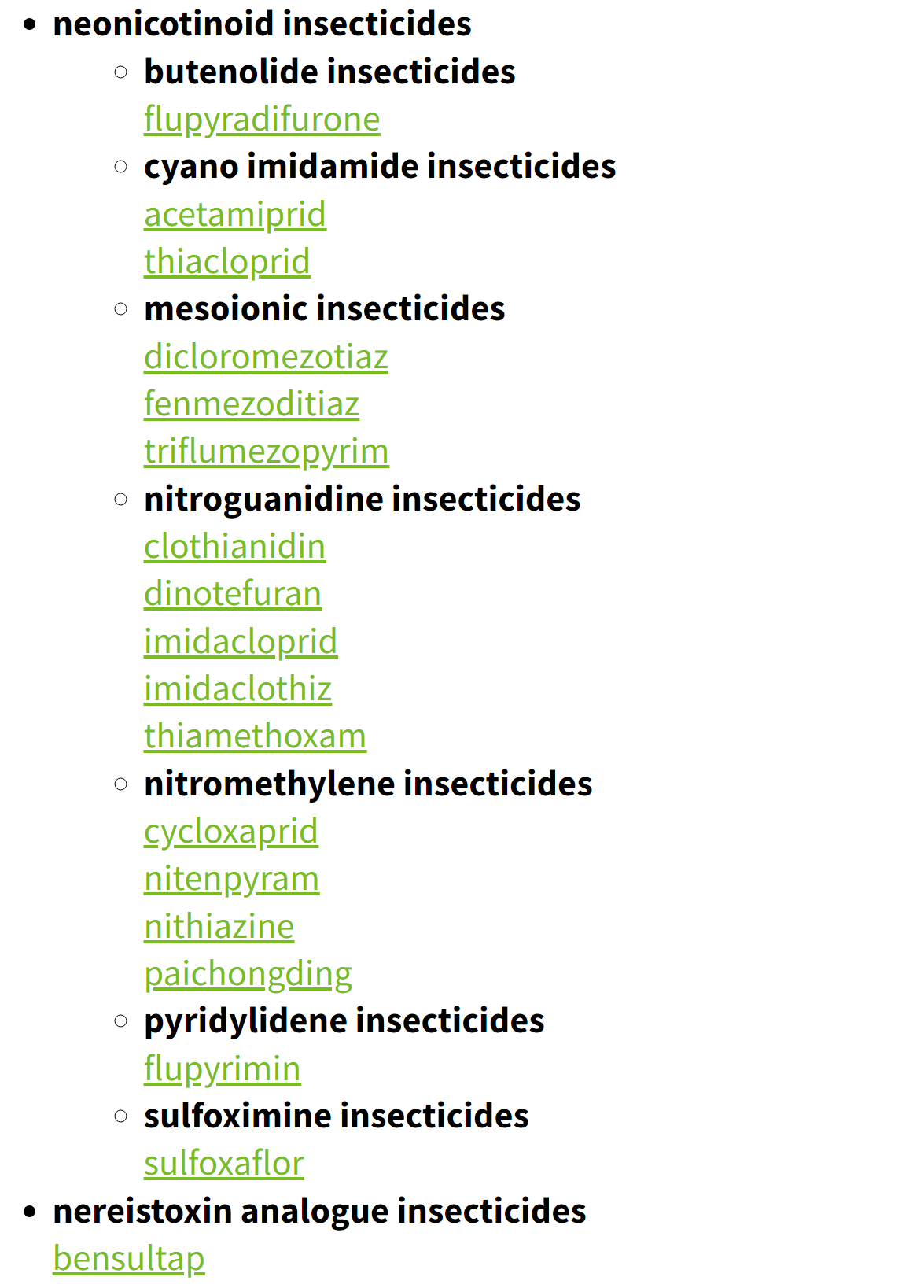Compendium of Pesticide Common Names
Basic Introduction
This website is intended primarily as a reference source for people familiar with pesticides and their chemistry. Much of the following is intended to provide users with a brief introduction to pesticides and their names in order to help them better utilize this website.
Commercial pesticide products are typically a formulated mixture of several chemicals. The chemical within this mixture that actually kills pests is listed on the label as the “active ingredient”. Other chemical components of the “product” might include solvents, carriers (e.g., silica) and surfactants – known as “inert ingredients” – whose purpose is to help deliver the pesticide to its intended target, e.g., a weed in the case of an herbicide, or to help move the active ingredient through the cuticle of a plant or insect.
There are >1800 different active ingredients (pesticides) listed in the Compendium, although not all have been used commercially and many others are now obsolete (no longer commercial). The purpose of this website is to provide a definition of each of those active ingredients. (Inert ingredients used in commercial product formulations are not included in the Compendium.)
How are pesticide active ingredients named?
“Systematic names” are used by chemists in order to provide a specific and unambiguous name to a particular chemical. Much like the scientific names used to unambiguously identify a particular plant or animal species, systematic chemical names are often long and complicated, but are necessary in order to definitively and uniquely name the millions of known chemicals as well as the ones that have yet to be discovered or invented. There are 3 main sets of rules for deriving systematic names, two from the International Union of Pure and Applied Chemistry (IUPAC) and the other from the Chemical Abstracts Service (CAS).
As an example, the insecticide known as “imidacloprid” has the following traditional IUPAC systematic name:
(E)-1-(6-chloro-3-pyridylmethyl)-N-nitroimidazolidin-2-ylideneamine
and the modern IUPAC PIN (Preferred IUPAC Name):
N-{(2E)-1-[(6-chloropyridin-3-yl)methyl]imidazolidin-2-ylidene}nitramide
The same insecticide has the following CAS systematic name:
(2E)-1-[(6-chloro-3-pyridinyl)methyl]-N-nitro-2-imidazolidinimine
In addition to a systematic name, CAS assigns a Registry Number to each chemical that it includes in the index to its main database, Chemical Abstracts. Unlike a systematic name, a Registry Number does not include any information about the identity of a chemical. If you have a Registry Number and you want to know to which chemical it refers, then you have to consult an index. This could be the complete index produced by CAS, or a smaller index such as the one produced by the World Health Organization for drugs, or the one for pesticides on this website.
For the insecticide named above, the Registry Number is:
138261-41-3
What are common names?
For many purposes, a relatively short and simple name would be more helpful than a systematic name or a Registry Number, and that is the role of common names. A committee (TC81) of the International Organization for Standardization (ISO) has the task to provide such names
For example, the common name for the insecticide with the IUPAC systemic name (E)-1-(6-chloro-3-pyridylmethyl)-N-nitroimidazolidin-2-ylideneamine is “imidacloprid”. This common name is made up from parts of the systematic name as shown in red.
Once a company discovers a new pesticide to commercialise they submit a proposal for a common name(s) to the ISO committee. The Committee then checks that the proposed name complies with the rules, that the name is not misleading, and is not likely to be confused with existing names for pesticides or drugs. If no problems are found with a proposed name, then it is approved and adopted for use in most countries
In addition to the ISO, some other organizations have approved common names for certain pesticides. This includes the World Health Organization where, in this instance, the common name is referred to as an International Nonproprietary Name (listed in the Compendium as WHO INN). Other organizations that have approved common names include the Japanese Ministry of Agriculture, Forestry and Fisheries (JMAFF), the Weed Science Society of America (WSSA) and the Standards Press of China (China), among others. Some pesticides have no approved common name and these are listed as "none" in the Compendium.
Approved common names can be used on pesticide labels, in product literature, in newspapers, in agricultural research journals, in abstracting services, or anywhere that does not require systematic names to be used. Unlike trademark names, common names do not belong to a company, and so anyone is free to use them.
What can I do with the Compendium?
The Compendium contains over 1800 data sheets (one for each common name), 15 indexes (listed on the Home page), and 21 chemical or biological activity classifications for each type of pesticide (such as herbicides herbicides and insecticides).
Check the authority which approved the common name of the pesticide
The Compendium lets you check whether or not a name is an approved common name. Look for the name in the Common Name index. If the name is present in the index, select it, and its data sheet will be displayed (perhaps with a different name from the one you used)
Each data sheet lists the organization which approved the common name, such as ISO, WHO, WSSA, etc.. The common name is shown as the title at the top of the data sheet. Just below the title there is a field called “APPROVAL ”. Using imidacloprid as an example, this field tells you that the name has been approved by the ISO. If you point your mouse at the entry in the “APPROVAL” field, you can see additional information regarding the organization that approved the common name. For imidacloprid this will display "Name approved by International Organization for Standardization."
Check the identity of a pesticide
Each data sheet lists the systematic names and the Registry Number for the pesticide. Each data sheet also contains a diagram of the chemical structure of the molecule, along with the molecular formula (the numbers of atoms in one molecule of the pesticide).

Check the activity of a pesticide
The “ACTIVITY” field on the data sheet tells you the type of activity of the pesticide. For example, imidacloprid is an insecticide, which is used to kill some types of insects. Other types of pesticides include acaricides (used to kill mites and ticks), herbicides (used to kill weeds), molluscicides (used to kill slugs and snails) and rodenticides (used to kill rats and related animals).
Find related pesticides
On most data sheets, the “ACTIVITY” field contains not only the main type of activity, but also the chemical groups to which the pesticide belongs. Select the names of the chemical group and this will show the selected pesticide together with a list of other pesticides that have similar activity and similar chemical structure.

Find out if a chemical has a common name
If you know the Registry Number for an active ingredient, then you can look it up in the Registry Number index.
If you know the InChIKey for an active ingredient, then you can look it up in the InChIKey index.
If you know a systematic name for an active ingredient, then you can try to look it up in the CAS Name index or the IUPAC Name index or the IUPAC PIN index. However, these can be difficult to use unless you understand chemical nomenclature.
Where can I find out about a brand name?
The most prominent name on a pesticide label is normally the brand name (also known as the trade name). These names are almost always registered trademarks, and therefore belong to the company that manufactures or supplies the pesticide. There are many thousands of these names, and there is no single place where they are all listed. Brand names are not included in this Compendium. The companion Online Pesticide Manual contains many brand names, including those for obsolete products. However, it is impossible to keep track of all brand names as they sometimes contain different active ingredients in different countries, and the actual active ingredients in a particular branded product are sometimes changed.